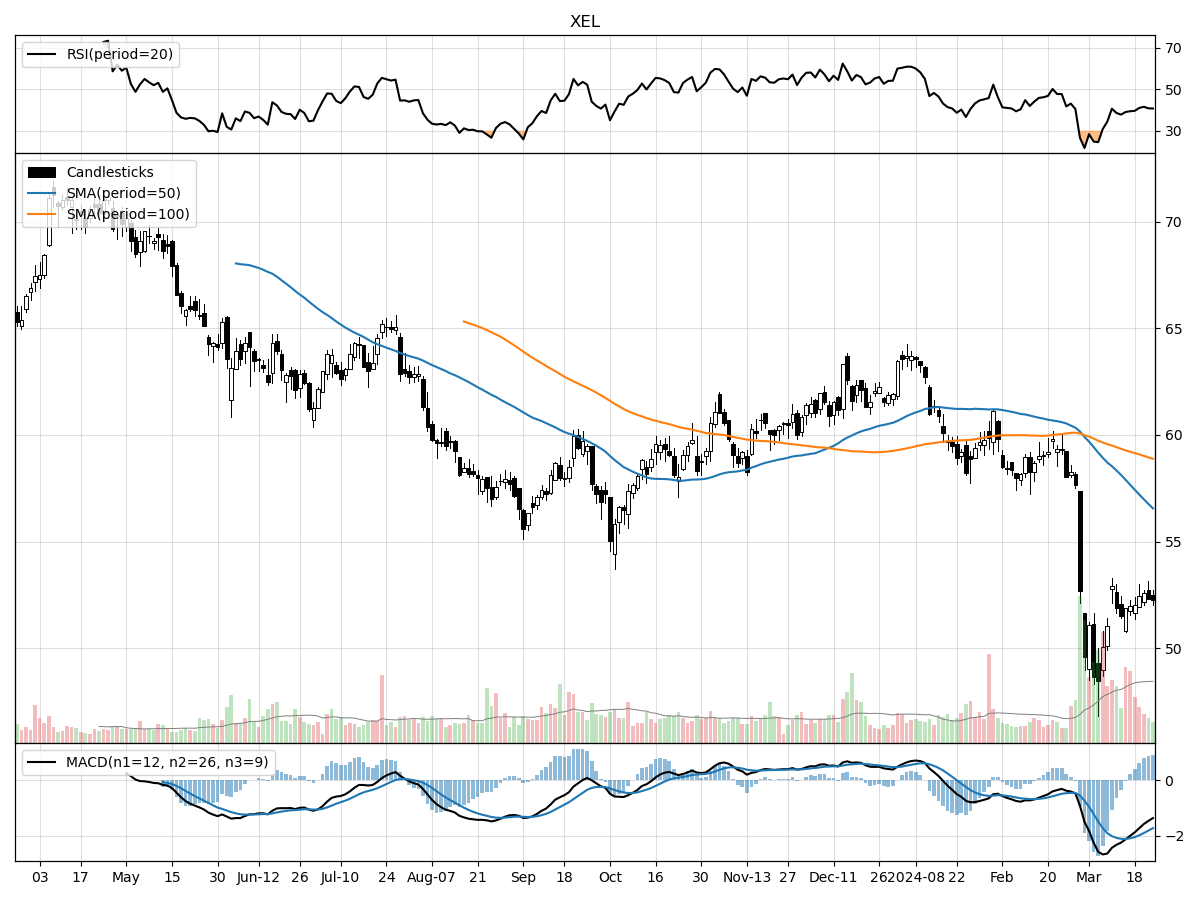Xcel Energy Inc., Large Cap AI Study of the Week

March 26, 2024
Weekly AI Pick from the S&P 500
Company Overview
Xcel Energy Inc., a utility holding company, operates through subsidiaries like NSP-Minnesota, NSP-Wisconsin, PSCo, and SPS, providing electric and natural gas services to around 5.4 million customers across eight states. The company generates revenue from electric services, purchased gas, and adjustment clauses tied to conservation and renewable energy initiatives. Xcel is regulated by state and federal agencies and offers detailed financial and operational information through various public disclosures.
The company's future financial and operational performance may be affected by factors such as safety, market risks, workforce issues, regulatory changes, and economic conditions. Xcel Energy is committed to a clean energy future, aiming for a carbon-free electricity supply by 2050, with an interim goal of an 80% reduction by 2030. They have already cut carbon emissions by 54% from 2005 levels and are investing heavily in renewable energy and transmission infrastructure to maintain service reliability.
Xcel's growth strategy includes expanding its wind and solar capacity, with new solar projects expected between 2024 and 2028 and around 1,900 MW of wind projects under development. They also operate nuclear plants contributing significantly to their carbon-free electricity. The company plans to retire or convert its coal units by 2030, adding new natural gas and storage capacities to ensure a smooth transition to cleaner energy.
Xcel Energy has received substantial federal support for projects like a clean hydrogen ecosystem, energy storage pilots, and grid resiliency, highlighting their commitment to innovation. They are enhancing customer experiences with digital tools, keeping bills low, and investing in community initiatives. The company emphasizes workplace safety, diversity, and inclusivity, with a significant portion of its workforce unionized and recognized for ethical practices.
In summary, Xcel Energy is actively transitioning to renewable energy sources, investing in technology and infrastructure to support this shift while maintaining a focus on customer satisfaction, community engagement, and a diverse and ethical workplace. The company's strategic moves to retire coal plants and expand renewable energy capacity, alongside federal support for clean energy projects, position it for future growth in the energy sector.
By the Numbers
Annual 10-K Report Summary for 2023:
- GAAP net income: $1,771 million (up from $1,736 million in 2022)
- Ongoing earnings: $1,851 million (up from $1,736 million in 2022)
- GAAP diluted EPS: $3.21 (up from $3.17 in 2022)
- Ongoing diluted EPS: $3.35 (up from $3.17 in 2022)
- Weather impact on EPS: Positive $0.009 compared to normal
- Electric margin increase: $50 million
- Electric revenue: $11,446 million (down from $12,123 million in 2022)
- Natural gas margin increase: $19 million
- O&M expenses: Decreased (specific amount not provided)
- Interest charges: Increased (specific amount not provided)
Quarterly 10-Q Report Summary for Q3 2023:
- GAAP net income for Q3 2023: $656 million
- Ongoing earnings for Q3 2023: $682 million (up from $649 million in Q3 2022)
- GAAP EPS for Q3 2023: $1.19
- Ongoing EPS for Q3 2023: $1.23 (up from $1.18 in Q3 2022)
- O&M expenses decrease for the quarter: $25 million
- O&M expenses increase year-to-date: $37 million
- Other income increase: Specific amount not provided
- Interest charges: Increased (specific amount not provided)
- NSP-Minnesota electric rate case increase: $316 million for 2022-2024
- PSCo Colorado rate increase effective September 2023: Specific amount not provided
- Planned investment in generation assets: $7.9 billion
- Planned investment in transmission capacity: $2.9 billion
- Recovery of under-recovered 2022 fuel costs: $123 million
- New Mexico electric rate case revenue increase: $33 million
- Texas electric rate case revenue increase: $149-$158 million
- Federal funding for clean hydrogen projects: Up to $925 million
- Federal funding for battery storage pilots: $70 million
- Grant for wildfire and extreme weather mitigation: $100 million
- Grant for high-voltage transmission lines: $464 million
- Fair value of net commodity trading contracts as of September 30, 2023: Negative $23 million for futures/forwards, Positive $24 million for options
- Change in fair values over the nine-month period: $33 million
These figures highlight the company's financial performance, regulatory impacts, investment plans, and risk management strategies.
Stock Performance and Technical Analysis

The technical analysis of this stock suggests mixed signals, as indicated by the various metrics. Firstly, the stock price being 7% above its 52-week low and 26% below its 52-week high indicates that the stock has retreated significantly from its peak but has also rebounded slightly from its lows. This could suggest that the stock is in a period of consolidation after a downtrend, but it has not yet shown strong signs of a full reversal.
The recent trading volume is more than double the longer-term average, which shows a heightened level of interest in the stock. This can sometimes precede a significant price move as it may indicate increased liquidity and participation by both retail and institutional investors. However, the direction of the move is not clear from volume alone. The money flow indicators present conflicting signals: moderate buying pressure could mean that there is a steady accumulation of shares by investors who believe the stock is undervalued, while distribution indicates that some holders of the stock are selling their shares, which could be a sign of a lack of confidence in the stock's near-term prospects.
The Moving Average Convergence Divergence (MACD) being bearish at -1.71 is a red flag for potential investors. The MACD is a trend-following momentum indicator that shows the relationship between two moving averages of a stock’s price. A bearish MACD indicates that the short-term momentum is moving downward faster than the long-term momentum, suggesting that the stock could continue to decline in the short term. This, combined with the recent price decline of nearly 10% in the last month and over 15% in the last three months, signals that the stock is currently in a bearish trend.
Given these indicators, a cautious approach would be prudent. An investor may want to look for additional confirmation of a trend reversal before considering an entry point, such as a bullish crossover in the MACD or other momentum indicators shifting to a more positive stance. It's also essential to consider the broader market conditions and any company-specific news or events that could affect the stock's performance. Technical analysis should always be complemented with fundamental analysis and a clear understanding of the company's financial health, competitive position, and growth prospects before making any investment decisions.

The ‘Bull’ Perspective
Xcel Energy Inc.: A Bright Investment Opportunity Amidst a Shifting Energy Landscape
Summary:
- Steady Earnings Growth: Xcel Energy has demonstrated a consistent increase in earnings, with ongoing EPS climbing from $1.18 in Q3 2022 to $1.23 in Q3 2023.
- Strategic Regulatory Advancements: The company has successfully navigated regulatory proceedings, securing rate increases across multiple states, which will bolster future revenue streams.
- Investment in Renewable Infrastructure: With plans to invest $7.9 billion in generation assets and $2.9 billion in transmission capacity, Xcel is positioning itself as a leader in the renewable energy sector.
- Resilience to Market Fluctuations: Despite broader economic and market uncertainties, Xcel's risk management strategies and diversified energy portfolio provide a buffer against volatility.
- Proactive Approach to Climate Change: Xcel is actively addressing climate change risks, with investments in clean energy and infrastructure to mitigate potential future costs and liabilities.
Elaboration on Key Points:
- Steady Earnings Growth
Xcel Energy's earnings growth is a testament to its operational efficiency and financial acumen. The company's increase in ongoing EPS from $1.18 to $1.23 year-over-year reflects a robust business model that is capable of delivering value to shareholders. This growth has been driven by higher sales, demand, and the smart recovery of infrastructure investments, as well as a reduction in operations and maintenance expenses. These numbers indicate a strong financial performance that is likely to continue, especially considering the company's proactive measures to manage costs and enhance its service offerings. - Strategic Regulatory Advancements
Regulatory proceedings can make or break utility companies, and Xcel Energy is navigating this complex landscape with finesse. The company has secured crucial rate increases, such as the $316 million hike for NSP-Minnesota and the upcoming rates for NSP-Wisconsin and PSCo in Colorado. These increases are not just a one-time boon; they represent a recurring revenue that will strengthen Xcel's financial foundation for years to come. The company's ability to work constructively with regulatory bodies underscores its strategic prowess and bodes well for sustained profitability. - Investment in Renewable Infrastructure
Xcel Energy's commitment to renewable energy is not just good for the planet; it's a strategic business move that positions the company at the forefront of an inevitable industry shift. By allocating billions toward generation assets and transmission capacity, Xcel is ensuring it remains competitive as the world transitions to cleaner energy sources. These investments will likely pay dividends as demand for renewable energy grows, and as more states and countries set ambitious green energy targets. Xcel's foresight in this area promises to be a key driver of long-term growth. - Resilience to Market Fluctuations
In a time of economic uncertainty and market volatility, Xcel Energy's diversified energy portfolio and risk management strategies stand out. The company's ability to manage commodity price risks through contracts and hedge plans demonstrates financial prudence. Furthermore, the recent news of central banks, including the Federal Reserve, moving toward a more dovish stance and potential rate cuts, may ease borrowing costs, benefiting Xcel's capital-intensive projects. The company's resilience in the face of market fluctuations instills confidence in its ability to maintain financial stability and protect shareholder value. - Proactive Approach to Climate Change
Xcel Energy's proactive approach to climate change is a strategic move that not only aligns with public policy but also mitigates future financial risks. By investing in clean energy solutions and infrastructure resilience, Xcel is reducing its exposure to climate-related liabilities and positioning itself as a leader in the transition to a low-carbon economy. The company's efforts to align with the Paris Agreement and address GHG emission regulations head-on will likely result in long-term cost savings and regulatory goodwill, further solidifying its investment appeal.
In conclusion, Xcel Energy Inc. presents a compelling investment opportunity, with its strong financial performance, strategic regulatory relationships, significant investments in renewable energy, resilience to market shifts, and forward-thinking approach to climate change. These factors, combined with the broader economic context and the company's adept management of identified risks, make Xcel Energy a bright prospect for investors seeking stability and growth in a transitioning energy market.

The ‘Bear’ Perspective
Upfront Summary:
- Regulatory Risks and Compliance Costs: Xcel Energy faces substantial regulatory risks that could lead to increased compliance costs and impact profitability.
- Dependence on Economic Conditions and Interest Rates: The company's performance is closely tied to broader economic conditions and interest rates, which are subject to change.
- Environmental Policy and Climate Change Challenges: Xcel Energy must navigate complex environmental policies and the physical risks of climate change, potentially incurring significant costs.
- Operational and Supply Chain Vulnerabilities: Operational risks and supply chain dependencies pose threats to Xcel Energy's consistent performance.
- Market and Credit Risks: Market volatility and credit risks could adversely affect Xcel Energy's financial stability and investment attractiveness.
Elaboration on Key Points:
- Regulatory Risks and Compliance Costs:
Xcel Energy operates in a highly regulated industry, where changes in policy can lead to substantial compliance costs. The company is already grappling with the financial implications of the Comanche Unit 3 litigation, which resulted in a $34 million loss. Additionally, the complex nature of state-level regulatory environments and the potential for disagreements on energy resource mixes present risks of stranded costs, which could reach millions of dollars. Regulatory proceedings, such as those in Minnesota and Wisconsin that led to rate case increases, are a double-edged sword; they can provide revenue boosts but also introduce uncertainty and potential for cost recovery delays. Furthermore, the company's nuclear generation segment is fraught with compliance and accident risks, with insurance limitations that could expose it to severe financial strain. - Dependence on Economic Conditions and Interest Rates:
Xcel Energy's financial performance is sensitive to broader economic conditions and interest rates. As the Federal Reserve projects rate cuts in 2024, this could lead to a lower interest income on cash balances, which has previously contributed to other income increases. Moreover, the company's recent increase in interest charges due to higher debt levels is a red flag, especially if the economic environment deteriorates or inflation persists, leading to higher borrowing costs. The company's capital-intensive operations require continuous access to capital markets, and disruptions here could hinder its ability to fund ongoing investments and meet its debt obligations. - Environmental Policy and Climate Change Challenges:
The shift towards cleaner energy and stricter environmental policies, such as those stemming from the Paris Agreement, place a heavy burden on utilities like Xcel Energy. The company may be required to make significant investments in renewable energy infrastructure, which, without guaranteed cost recovery, could impact its bottom line. Climate change also presents physical risks, including the potential for increased operational costs and the need for additional investments to mitigate damage from extreme weather events. Xcel Energy's commitment to transitioning away from fossil fuels and towards renewable energy is a costly endeavor that could affect its financial performance if not managed carefully. - Operational and Supply Chain Vulnerabilities:
Operational risks, such as the potential for accidents and outages, could lead to financial losses, environmental damage, and reputational harm. Supply chain issues, particularly those affecting the deployment of electric meters and transformers, could extend into 2025, further delaying projects and increasing costs. Xcel Energy's reliance on suppliers for essential inputs, coupled with commodity price volatility, can also impact customer demand and its financial results. These supply chain risks are exacerbated by the current global economic climate, with inflation and tariffs potentially increasing operational expenses. - Market and Credit Risks:
Market volatility poses a significant risk to Xcel Energy's financial stability. The fair value of net commodity trading contracts showed a negative $23 million for futures/forwards, indicating potential losses that could arise from future market fluctuations. Credit risks, such as customer non-payment or insolvent counterparties, could also lead to financial strain. A downgrade in credit rating would likely increase borrowing costs, putting additional pressure on the company's finances. Xcel Energy's reliance on cash flow from subsidiaries is subject to statutory and regulatory restrictions, which could further constrain its financial flexibility.
In conclusion, while Xcel Energy has shown resilience in its recent financial performance, investors should be wary of the numerous risks that loom on the horizon. Regulatory challenges, economic dependencies, environmental policies, operational vulnerabilities, and market uncertainties present a complex web of potential pitfalls that could undermine the company's financial stability and growth prospects. Prudent investors would do well to consider these factors before making any investment decisions regarding Xcel Energy Inc.




Comments ()